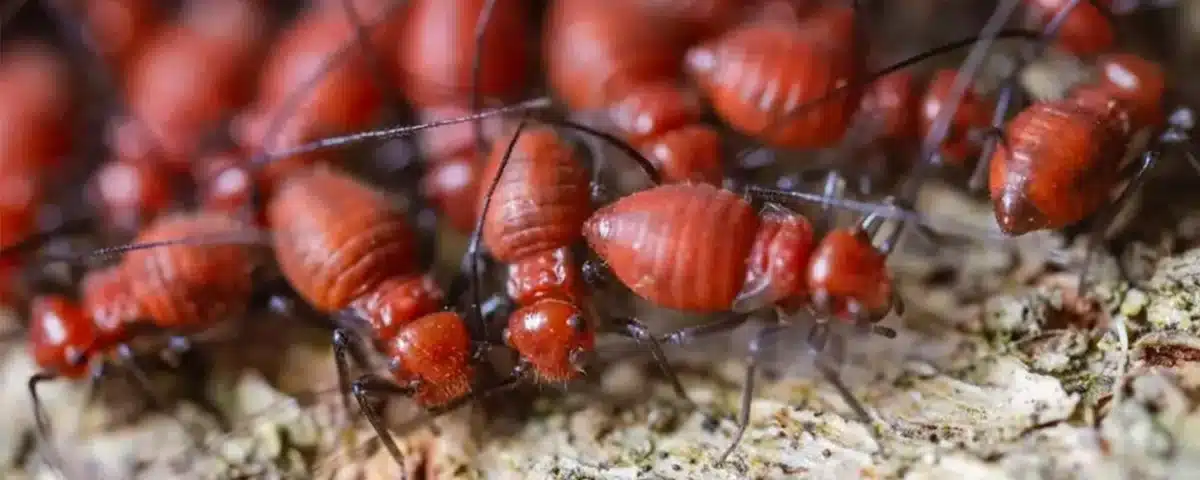Sunset City
April 29, 2024The Adventure Park at Long Island
April 29, 2024Termites are a burden on homeowners, but there are ways to stop them before they become a problem. Termites can be very destructive pests that eat away at the wood and leave their droppings behind. They also secrete formic acid which has an unpleasant odor. If you notice any of these symptoms in your home, it’s time to call for help because termite infestations should not be taken lightly!
Termites are large social insects that construct large mounds known as ‘termitaria’ out of chewed plant material. They have an organized caste system with each member playing a specific role within the community; workers harvest vegetation, carry it back to the termitaria and chew it up for the reproductive caste to feed upon. The queen, or female termite, is fed a special diet that keeps her laying between 2-4 eggs per day which she does continuously throughout her life and thus increasing the size of the colony exponentially until they reach a tipping point where they destroy their environment and move on.
Many different species of termites live in the United States, including subterranean termite and drywood termite. The most common type is the subterranean termite, which creates mounds out of soil throughout your yard or immerses themselves into wooden structures. Drywood termites do not create these mounds; they simply chill inside a dead tree branch or other wood material.
These pests can cause more harm than a simple case of wood rot. If left undetected, termites can cause structural damage to your home such as posts and beams. To prevent an infestation, termites will look for parts of the house that have moisture or are vulnerable to decay. This could be an area such as behind a water heater, or in the basement. They could also look for a dead tree branch to use as shelter.
Signs of a termite infestation
Problems with termites can be found by looking for these signs: Sawdust piles (Subterranean termites), Small holes in wood, Curling wall paper as a result of moisture damage and Termite wings on your walkway or decking, or even inside your home (usually drywood)
One of the first indicators of a possible termite infestation is the sawdust piles (subterranean termites) near the base of your house and they usually will leave behind small holes in wood. Another sign could be curling wall paper as a result of moisture damage. One may also notice winged insects, either inside or outside their home- which can only mean one thing: drywood termites are on the premises.
Sometimes people may find pellets and secretions that smell bad all the time. These appear to be an indicator of a problem, especially if they are found in certain areas inside the house. This is why it’s important to contact professional help right away when you think you have a termite infestation.
These pests can cause more harm than just wood rot. If left undetected long enough, termites can cause structural damage to your home such as posts and beams- which means thousands in repair bills! The best way to avoid this problem is by hiring a professional exterminator right away and treating your home for these unwanted guests before there’s too much damage done!
How to prevent an infestation before it’s too late
One of the best ways to prevent a termite infestation is by keeping your home dry and heated. It’s also important to never knock down wood piles or leave piles of wood in contact with the ground. Another way to avoid these pests is by using wood that has been pressure treated, especially for any new construction you’re planning on undertaking. If you live in an area that is prone to flooding or excessive rainfall, drainage issues can be avoided by installing raised building platforms. High water tables should also be monitored because this could lead to excessive moisture in your house or even termites getting up under your house, through foundation cracks, and into the wood frame.
As a homeowner, it’s also important to make sure that paint products used for your home are not toxic to termites. This is why it’s important to ask for a paint or finish that contains permethrin, bifenthrin, or imidacloprid in order for them to be effective against these pests. Another product you can put around the foundation of your house is Advance Termite Bait Stations. These stations use an active ingredient called dehydro- d -chrysanthemate and are available online at many pest control sites.
It’s also important to recognize how the life cycle of termites works and what their natural habitat looks like so you will know if they are present in your wooded areas near your home. If you notice a lot of swarming during the summer, it’s probably because you have a nest nearby because termites usually swarm when they are ready to start new colonies.
Dehydro- d -chrysanthemate is the active ingredient in many products, including Advance Termite Bait Stations, that help homeowners keep their homes free from these pests before they get out of hand. These stations contain dehydro- d – chrysanthamates as well as other food sources for the termites and they also can be placed outdoors so long as it’s done correctly. The process involves making a 2″x4″ hole into your soil about 3 feet down (depending on state laws) and putting one bait station inside it, making sure to seal the hole back up.
These stations are effective because they have a slow-release food source that is packaged in foil pouches, which will last for about 5 year. They also have a nonrepellent odor so termites won’t notice it and an anti-caking agent to keep the product from getting sticky or caking over. The process of setting these bait stations requires special equipment called tongs (which can be purchased at most hardware stores) and must be done by an experienced technician.
Ways to keep your home from being vulnerable to termites
Termites are a threat and can do severe damage to your home, causing problems such as wood rot. They can also cause structural problems like posts and beams that will cost you thousands of dollars in repair work. The best way to avoid this is by calling for help right away and getting professional exterminators in to evaluate the situation.
There are many things homeowners can do to prevent termites from taking over their homes, so keep reading for some helpful tips!
One way you can protect your home from termites is by making sure it’s insulated against water or heat loss. Keeping the house dry and heated is important because it will get rid of any moisture areas they might move into- this includes building platforms elevated on blocks if you live in a flood zone or just making sure the house is insulated to protect it against moisture.
Also, make sure trees and shrubs are properly maintained, trimmed back and away from your home’s foundation. If you don’t want to spend money on professionals doing this work for you, there are some things you can do yourself- focus on areas where deadwood meets the house such as under windows and decks that have the most contact with soil. Also avoid putting pressure treated wood near your house because it contains chromated copper arsenate (CCA) which is harmful to termites.
If you notice that your home has been invaded by these pests or if you live in an area prone to them, it might be time to call for help. It’s important to take action as soon as you can because the damage they cause can be very expensive and time consuming to fix. The longer you wait, the more of a problem it will become- so don’t hesitate!
If you see any swarming in your home or your yard, this is an indicator that you have termites nearby. This usually happens in June when the queen lays eggs for new colonies (nest). Swarms usually occur about 2 to 4 weeks after hatching and are often black with white wings. They also usually occur early in morning or late evening hours. If there is any visible evidence of swarmers around your house, contact a local pest control company immediately!
The best prevention is to keep your home dry and free of wood that they can use to build their nests. Inspect your property regularly; through the spring, summer, and fall, but especially in the spring. You’ll want to check both inside and out because most termite nests are close to the ground and can be hidden by wood, mulch, or soil. If you notice any damage or see termites for yourself, call a professional immediately!
When to call professional help?
It’s often the case that people don’t notice they have a termite problem until it becomes too late. One of the most important things you can do is call for help right away if you think there’s a problem. The sooner you act, the easier it will be to fix your home and avoid costly repair work later.
If you have noticed any of the signs mentioned above or if there is visible termite activity in your home, it’s best to call a professional before they do any serious damage. It might be hard to tell how much damage has already been done- and this can be a costly mistake if you don’t act quickly!
You should also consider calling a professional help for other reasons as well:
Your home is very old (older than 25 years)
There are lots of wood treatments in your home (stain, paint, etc.)
The wood in your home has been exposed to moisture or flooding.
You live near areas with known termite problems such as swamps and mountainsides.
There are dead trees near your home or wood used to build decks, porches, patios and yards.
If you have termites in your home, it’s important that you inspect your yard for signs of activity from these pests. You can also call a professional for help if you don’t know whether the problem is inside or outside your house- they’ll be able to spot any damage before it becomes serious!
Termites are one of the most destructive pests in the co. They can wreak havoc on your home, damaging walls and furniture as they eat through wood to get at their food source. Luckily, there are a number of ways you can prevent termite infestations from happening or deal with them if they do show up in your home. In this blog post we’ve covered some of the most common ways that termites enter your home and how you can use these methods for prevention. If you still have questions or concerns about whether your home is at risk from termite infestation, contact us today! Our team will be happy to help answer any lingering questions you may have and set up an inspection if necessary so that you can rest easy knowing everything is taken care of.





